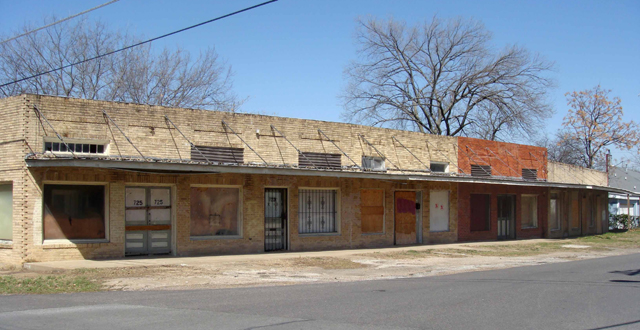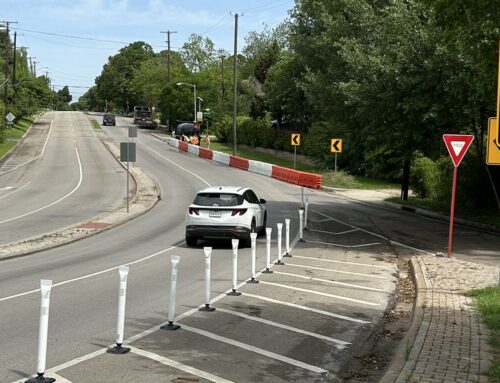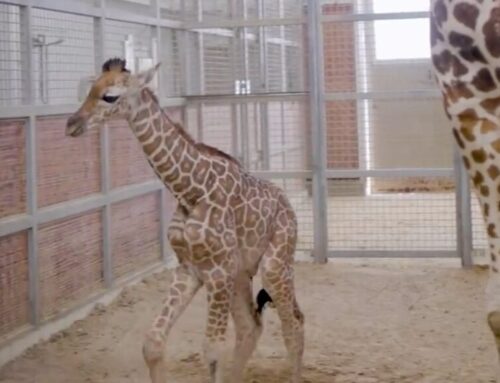
Abandoned retail buildings occupy the 700 block of Pierce in the North Cliff neighborhood. Photo by Mary McLauhlan
I like to drive around Oak Cliff.
Quite frankly, I’ve told friends that if I ever disappear and my car and body are found in some strange place … (and no foul play is involved) it’s because I was just curious and took a spontaneous “detour” down some street I’ve never visited before and, obviously, expired behind the wheel. You’d think by now I’d have been just about everywhere in The Cliff, but there are still streets and parks and places to experience. And, time is passing. So … I’m trying to do it all before my children determine it’s time to confiscate the keys and sell my car, and I find myself grounded, permanently.
A few months back, on one of my Sunday afternoon excursions, I decided to explore the North Cliff neighborhood off of West Clarendon. The neighborhood is an assortment of brick and frame houses from different eras that range from Tudor style to old farmhouse leftovers, certainly an interesting mix. Slowly driving up one street and down another, I meandered around taking in the ambience. Then, suddenly, my lazy, relaxing trek halted when I came upon an aging and deserted late-1920s retail strip in the 700 block of Pierce Street, with an odd placement (per today’s world): nestled inside a residential neighborhood. The dated, vintage strip center looked like something out of a Bonnie & Clyde movie or some Depression-era drama.
Somewhat recalling the sight from an earlier and rapid shortcut through the area, this time the cozy enclave of brick buildings captured my attention. I was immediately enchanted.
These one-story, attached, retail buildings with cable-supported awnings reminded me of those movie or TV scenes where an old-timer from another era comes back for a visit and sits on the corner, staring at the buildings while envisioning how the town used to look back in the day. Imagining housewives in cotton shirtwaist dresses and grandmothers in 1930s-1940s orthopedic shoes — all with their Olivia Walton-esque hats and carrying brown paper bags of groceries. I could also picture 10-year-old boys in knickers and caps perched atop vintage bicycles, while milk and bread trucks made deliveries and the locals gathered under the awnings, which is probably a fairly realistic scenario for that era.
The buildings seemed, to me, to be pleading for a reno.
About two weeks after my visit, an acquaintance, Mary McLachlan, an avid cyclist, historical enthusiast and amateur photographer, posted some photos of the buildings online. She told others how she was recently cycling in the area, and the structures caught her attention. Like me, she was smitten. (I think we must be twins separated at birth … except for the cycling, of course.) A flood of comments and messages followed the post, most of them chock-full of delightful details and heartwarming stories.
Brian Haney, whose mother owned the J&J Beauty Shop in the strip, said, “[It] seemed like folding towels at home was never ending when I was a kid.”
“Sims grocery store was there,” typed Stephany Pitt White. “My mom would send me for milk, bread and cigarettes. Yep … a 10-year-old buying cigs.”
JoEllen Glasgow McVey posted that she and her grandmother often walked from Gladstone Drive to these little stores. “One was a variety store where my grandmother bought thread and other sewing materials,” McVey says. “That was a very looooooooong time ago!”
According to Suzanne Welsh Burch, “A laundromat with front-loading machines was one of the center buildings. In the late ’40s. Mom and I would go get the family’s clothes washed, then drive the wet stuff home to hang on the line. We got our very own machine in 1951 when baby sister came.”
Ken Shields had a paper route on Catherine Street in the ’50s. “There was a grocery store and a bar. Can’t remember the rest. My older brother took the paper into the bar … dark and smoky in there … scared me.” Shields and his brother purchased Baby Ruth candy bars and Cokes in the grocery to celebrate the end of the paper route. “Then,” he wrote, “me ‘n my brother would ride our Radio Flyers down the hill and crash onto the well-kept yard at the bottom of the hill … good times.”
On the other side of Pierce sits an old vacant ceramics store, formerly Coat’s Variety Store, and beside that a more modern building, built in 1939.
“One of the stores was Bateman Ceramics,” typed Donna Clark Dorflinger who lived on Brooklyn Street. “My mother did business with him. He was a sweet man. The other store was a grocery store, where we went for groceries. On the other corner of the store was [a] store like a 7-Eleven.”
“Randy Reynolds’ aunt and uncle owned the tiny store at the end of the [streetcar] line on Pierce and Brooklyn,” posted Diane Lovelace Rogers, who drives by the old buildings several times each week. “Only the concrete slab is there [now]. I love these little buildings and wish I could think of something that could be done with them today.”
These charming relics from the past remind us how life used to be, before everyone had a car and people rarely locked their doors, and when most of the moms were home during the day. Although change is constant, and progress invariably pushes out the old, I’d love to see these charming structures repurposed in some way.
However … I just checked my purse and the keys are still there. And my car’s still in the garage. So I’m outta here! I’ve got places to see. Better go for a drive while I still can.





